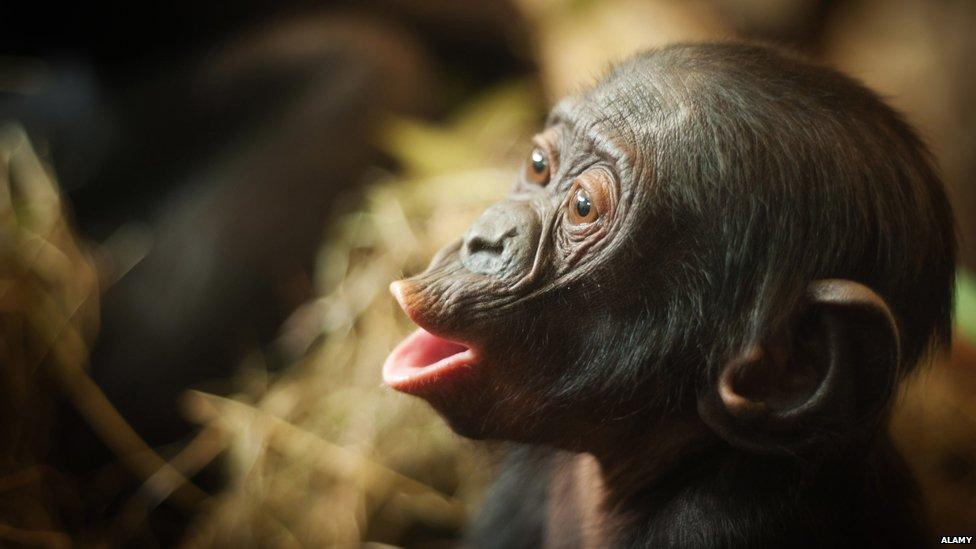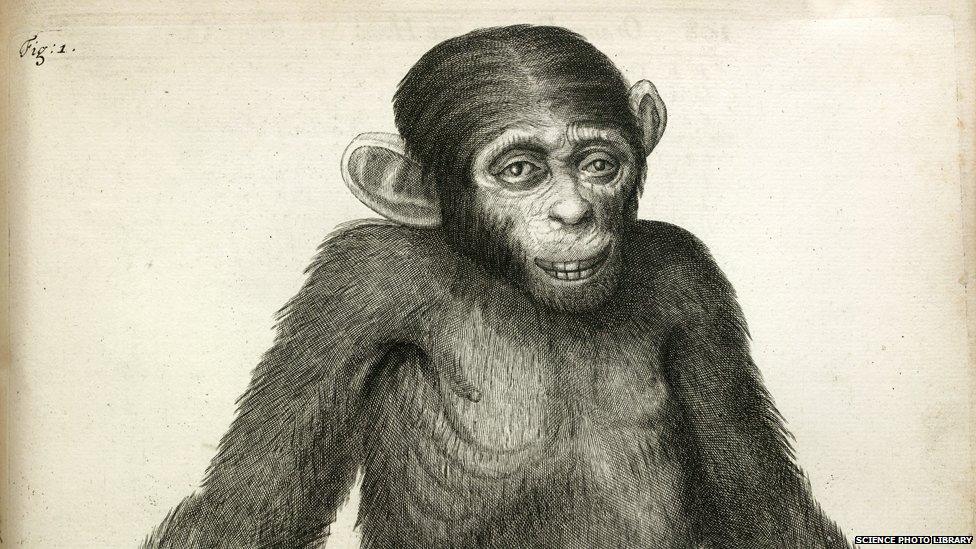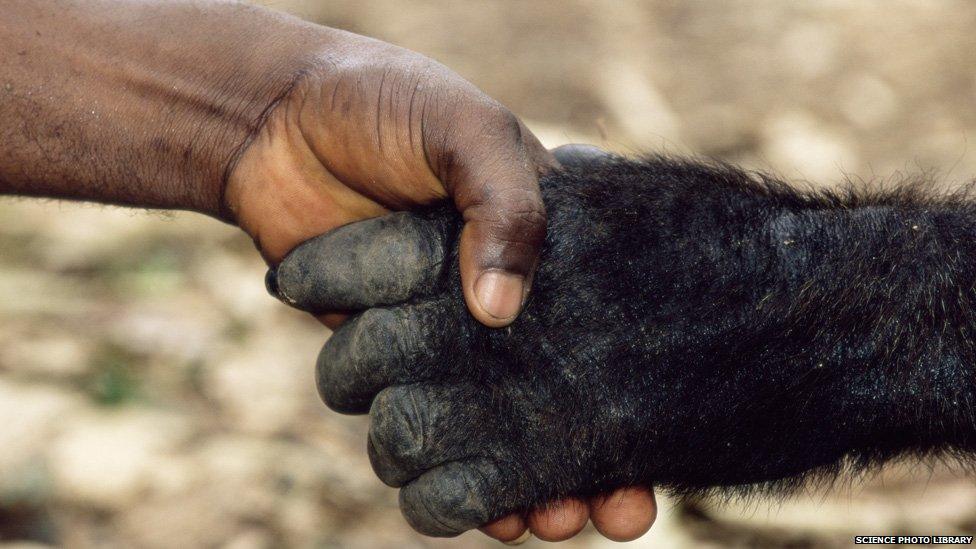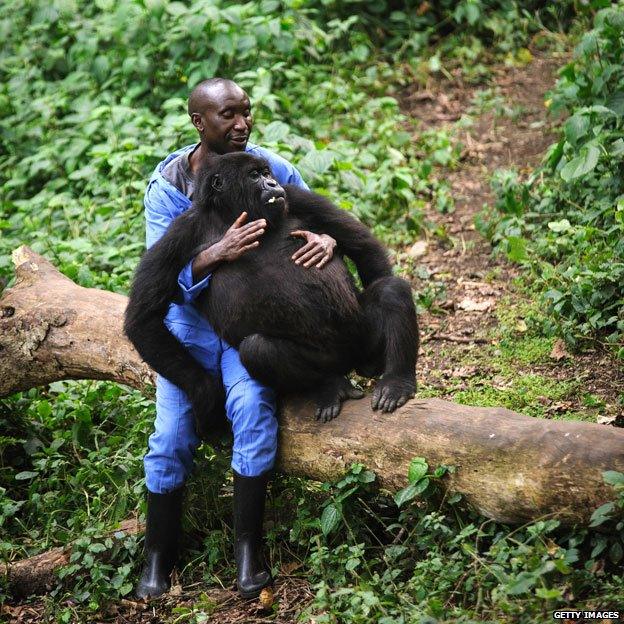Listening to the language of apes
- Published

The similarities between apes and people have long fascinated scientists. Yet, writes Mary Colwell, the differences can be just as thrilling.
"When you look into the eyes of an ape you see an intelligent, self-aware animal looking back at you and appraising you," says primatologist Charlotte Uhlenbroek, who has spent years observing apes in their natural environment. "I often wonder, what do they make of us when they look at us?"
Apes and humans are so similar it is impossible not to wonder what exactly separates us from our closest relatives on earth. "There is no other creature that so charms and fascinates the beholder as do these little effigies of the human race," wrote R L Garner in 1896. In fact Garner was one of the first people to actively try to discern the differences by living with chimpanzees in West Africa. He noted their physical similarity, but also their social bonding, range of emotions and care of their young.
But it was their language he was most intrigued by. They seemed to talk to each other, but what were they saying and why? "The sounds uttered by these apes have all the characteristics of true speech," wrote Garner. "The speaker is conscious of the meaning of the sound used, and uses it with the definite purpose of conveying an idea to the one addressed; the sound is always addressed to some definite one, and the speaker usually looks at the one addressed; he regulates the pitch and volume of the voice to suit the condition under which it is used; he knows the value of sound as a medium of thought. These and many other facts show that they are truly speech." The language of the apes has fascinated us for centuries.

Find out more

Image of a chimpanzee taken from Orang-Outang, sive Homo Sylvestris: or, the Anatomy of a Pygmie, compared with that of a Monkey, an Ape, and a Man
Listen to Natural Histories: Monkeys and Apes on BBC Radio 4 on Tuesday 2 June at 11:00 BST

On 1 June 1698 the foremost anatomist of the day, Edward Tyson, came before the Royal Society to present his findings on the dissection of a pygmy chimpanzee. This young animal had arrived in England from Angola and had survived for two months before succumbing to an infection caused when it damaged its jaw in a fall on board the ship. His account of his work was published in his book, Orang-Outang, sive Homo Sylvestris: or, the Anatomy of a Pygmie, compared with that of a Monkey, an Ape, and a Man: with an Essay concerning the Pygmies of the Ancients. Among all the measurements and descriptions of muscle and bone is a touching story of how the animal was treated by the ship's crew. It was dressed in clothes, fed the same food at table and would even "lie in a bed". This was clearly an animal that intrigued the sailors. They, like us, looked at our closest relatives and saw reflected back the essence of their own humanness.
One finding was of particular interest - the vocal chords. Tyson could see very little difference between the chimp's throat and ours. "'Tis exactly as it is in man," he wrote. So why didn't it speak? One theory was that if chimps allowed us to hear them talk we would enslave them, so they remained silent in the presence of humans. At a time when slavery was rife, the chimps were afraid that as our closest relative they would also be taken and subdued.
Over a century after Tyson's pygmy chimp a mandrill was brought to Bristol on a slave ship and was taught to drink gin and smoke a pipe. "Happy Jerry" sat outside the Exeter Exchange in the Strand in London and was hugely popular - he was even invited to tea with the king. If we laugh today at the idea of Tyson's pygmy chimp being dressed in clothes and Jerry smoking his long-stemmed pipe it is worth remembering the adverts for PG Tips tea in the 1970s, when chimps had tea parties and dressed as boys and girls.
Our view of apes has evolved and transformed over time and has been bound up with philosophy and religion as well as science.

In the 17th Century the veil between science, myth and religion was thin. An animal was not merely a creature to be described but an entity that embodied our view of the world and our place in in it. For Tyson, the reason the chimp didn't speak was because it was not a reasoning being. Erica Fudge from the School of Humanities in Strathclyde University says, "Humans were different to animals because we have a thing called reason, which of course you can never find in the body, it is a spiritual essence, and so the fact that the chimpanzee has vocal chords that should allow it to speak and doesn't speak, reinforces the status of humans as the reasoning creature."
The notion that we are different from other life on earth because of some spiritual essence would not be an acceptable conclusion to scientists today, but we are still on the same quest - to discover just how close we are to apes. And it is to language that we turn for many of those answers. R L Garner was the first to try to teach a chimpanzee to speak, but his success was limited. Subsequent research revealed that bonobos, chimpanzees, gorillas and orang-utans are capable of communicating through language, but not in the same way.
Seventy years ago attempts were made to train apes to speak English by taking newborn chimps into a household with a newborn baby and raising them together. By the time they were three the chimp far out performed the child in physical ability but could only pronounce a few words very badly. The human youngster at this age had already mastered several hundred words. It was then realised that in reality a chimp's mouth and throat cannot make sounds in the same way as ours and in the wild they only vocalise when excited, non-verbal communication was far more important for day to day activities. This spawned a whole area of new research based on teaching sign language, specifically Ameslan, the American version of signing. This was a turning point in our understanding of apes. Chimpanzees quickly learn around 200 words and phrases, and more importantly start to put words together to create new concepts. For example a famous chimp called Washoe saw a swan on a pond and made her own name by combining water and bird together.
Over the following decades we have experimented with chimps in many and ingenious ways, the 1970s and 80s was the golden age of ape language research. As well as sign language chimps were taught to press buttons with pictures representing words to ask for food, to see a film or even to be tickled. But it was work with a pygmy chimp that purportedly showed how sophisticated this species' language is. Kanzi seemed to have the ability to make simple sentences, to comment on what he was doing and even say what he intended to do in the future. It is worth noting though that the renowned primatologist Robert Sapolsky denies that these experiments showed anything other than the ability of apes to copy humans. The language experiments have at present all but ceased.
The past century has seen our relationship with apes transform from beasts of the jungle to creatures that are intelligent and communicative. Genetic studies show that we are 10 times more closely related to chimps than a mouse is related to a rat. The fact that Tyson's pygmy ate with a fork but soiled his bed and that Jerry could suddenly revert to "bad behaviour" made us realise that apes can entertain and appal us at the same time. It is the differences that thrill us as well as the similarities. The language of apes remains a mystery yet to be solved but we never tire of exploring just how close we really are.

More from the Magazine

Park ranger Andre Bauma has been taking care of orphaned mountain gorillas at Virunga, Africa's oldest national park, and he says he loves them as if they were his own children.

Listen to Natural Histories: Monkeys and Apes on BBC Radio 4 on Tuesday 2 June at 11:00 BST or catch up afterwards on iPlayer.
Subscribe to the BBC News Magazine's email newsletter, external to get articles sent to your inbox.